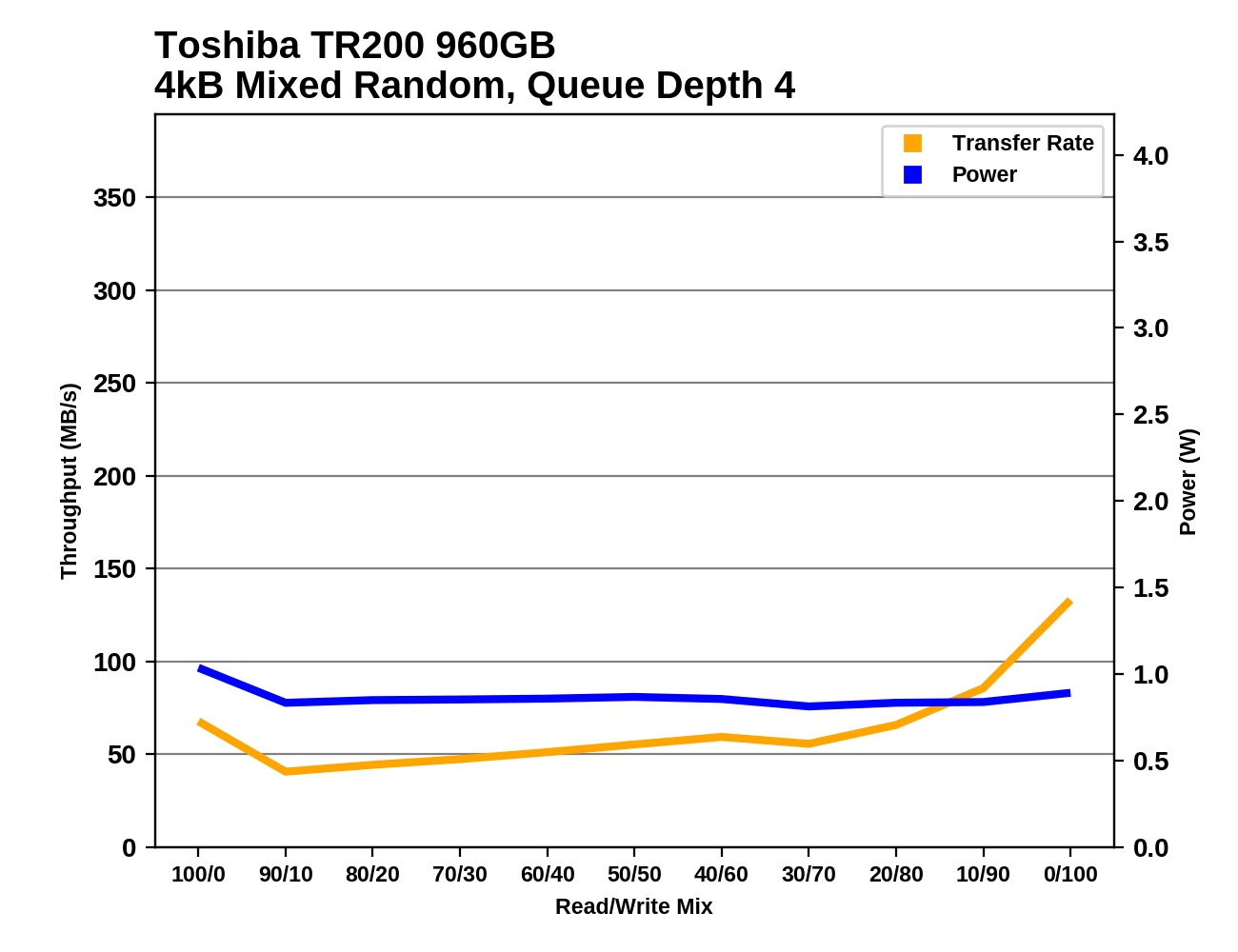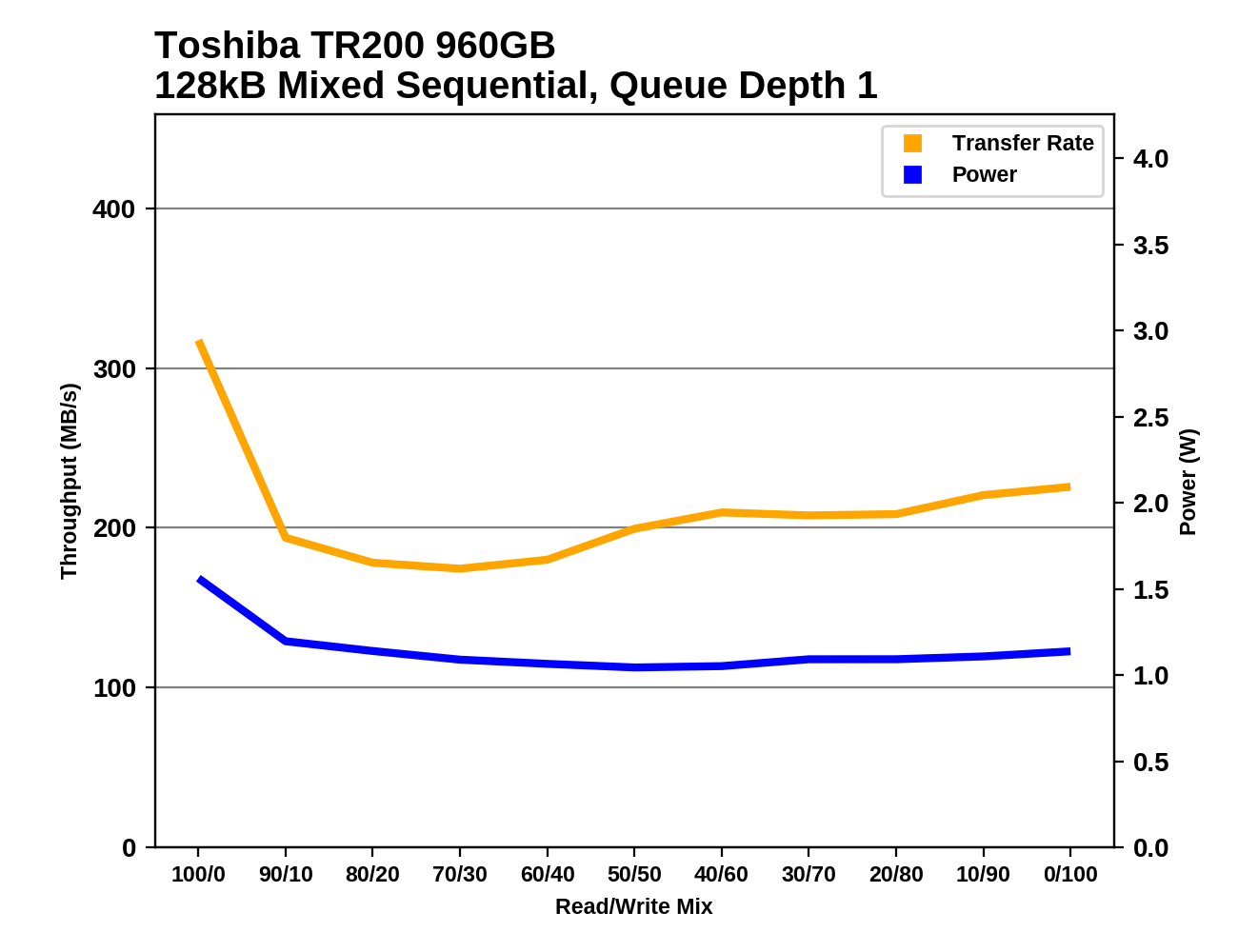The Toshiba TR200 3D NAND SSD Review: One Step Forward, One Step Back
by Billy Tallis on October 11, 2017 7:00 AM ESTMixed Random Performance
Our test of mixed random reads and writes covers mixes varying from pure reads to pure writes at 10% increments. Each mix is tested for up to 1 minute or 32GB of data transferred. The test is conducted with a queue depth of 4, and is limited to a 64GB span of the drive. In between each mix, the drive is given idle time of up to one minute so that the overall duty cycle is 50%.

The mixed random I/O performance of the Toshiba TR200 is much faster than the HP S700, but is slower than everything else, even the earlier Trion/TR series drives. Contemporary budget SSDs like the ADATA SU800 and Crucial MX300 are more than twice as fast.

The power efficiency of the TR200 during the mixed random I/O test is a marked improvement over the TR150 and is more than twice that of the HP S700, but that's not enough for the TR200 to rate much better than acceptable.
 |
|||||||||
The performance of the TR200 during the mixed random I/O test traces out a common bathtub curve shape, with performance dropping after the initial pure reads phase and climbing very slowly as the proportion of writes increases, before accelerating near the end of the test as the workload shifts to mostly writes. The TR200s don't show a large spike in performance at the very end of the test like the TR150 does, but at least they don't bottom out anywhere near as low as the HP S700.
Mixed Sequential Performance
Our test of mixed sequential reads and writes differs from the mixed random I/O test by performing 128kB sequential accesses rather than 4kB accesses at random locations, and the sequential test is conducted at queue depth 1. The range of mixes tested is the same, and the timing and limits on data transfers are also the same as above.

The larger two Toshiba TR200 models are marginally faster than their TR150 predecessors on the mixed sequential I/O test, but the 240GB has lost more than 12% of its overall performance. All of the TR/Trion series drives remain at the bottom of the chart, well below even the other DRAMless SSDs.

The TR200 climbs out of last place for power efficiency, and the 960GB model in particular is near the top of the chart along with the other DRAMless SSDs. The smaller two capacities have fairly average efficiency.
 |
|||||||||
All three of the TR200 models lose a lot of performance when writes are first added to the workload, but they regain a bit of performance through the first half of the test. The 960GB model gains a bit more performance in the second half of the test while the smaller models drop off again. The drives that do well on this test mostly either regain significant performance in the second half, or show steady increases across the entire test.










50 Comments
View All Comments
lmcd - Thursday, October 12, 2017 - link
Isn't BX300 NVMe? Or is it SATA? 850 Evo might be the best "compatibility" option if the former.mapesdhs - Friday, October 13, 2017 - link
Curiously though, the 850 EVO still has a very good reputation. But for the price, it would be my default recommendation.sonny73n - Saturday, October 14, 2017 - link
All three are SATA3.takeshi7 - Wednesday, October 11, 2017 - link
Anandtech reviewed the Crucial BX300 and it seems very good.Samus - Wednesday, October 11, 2017 - link
BX300 is the only competitive drive at the moment (mostly on price) but older MX200’s can occasionally be found cheap and they have the capacity advantage.sonny73n - Thursday, October 12, 2017 - link
Are you capable of using the search function on AT?Ratman6161 - Thursday, October 12, 2017 - link
Seriously dude, your mom densest want an SSD for Christmas.HollyDOL - Wednesday, October 11, 2017 - link
Hm, with given price the performance is really poor... Unless you absolutely need to cut power requirements down in mW scale for some reason, I can't imagine it being a good choice.Valantar - Wednesday, October 11, 2017 - link
If this does indeed signal the beginning of the end of the NAND shortage, that is more than welcome. If that happens, I also hope we see significant reductions below MSRP for this over time, to the tune of i being noticeably cheaper than DRAM-equipped drives. In the next year, I want cheap 250-500GB SSDs for my XBONE and PS4, and DRAM-less drives should fit that bill nicely (the USB interface will limit them already, so I don't see the value of springing for anything above bargain-basement as long as it significantly outperforms an HDD).nathanddrews - Wednesday, October 11, 2017 - link
With 100GB games already shipping, will 250-500GB cut it anymore?